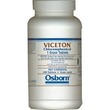Pronunciation
klor-am-FEN-i-kol - Pronunciation guide
Brand Names
- Vetracoracin Opthalmic Ointment
- Viceton
Description
 Chloramphenicol is a broad-spectrum bacteriostatic antibiotic that works by preventing bacteria from growing or reproducing. It is effective against many types of bacteria and is easily absorbed orally and easily distributed throughout the body.
Chloramphenicol is a broad-spectrum bacteriostatic antibiotic that works by preventing bacteria from growing or reproducing. It is effective against many types of bacteria and is easily absorbed orally and easily distributed throughout the body.
Usage
Chloramphenicol is used to treat a variety of infections in horses and is particularly effective with those caused by anaerobic bacteria. It is used to treat peritonitis and abdominal abscesses, ophthalmic infections, as well as other infections, because it is easily absorbed and distributed throughout the body of the horse. Most susceptible disease organisms will respond to chloramphenicol therapy in 3-5 days when the recommended dose is used.
Dosage and Administration
 Chloramphenicol Chloramphenicol |
||||
|---|---|---|---|---|
| Method | Dosage (click row for calculator) |
Concentration | Period | Duration |
| Opthalmic ointment | Small amount1 | 1% | Every 3 hours for 48 hours, then every 3 hours during the day. | Until 2 days after eye appears normal |
| Oral | 45-60 mg/kg | 250 mg/tablet | Every 8 hours | NA |
| Oral | 45-60 mg/kg | 500 mg/tablet | Every 8 hours | NA |
| Oral | 45-60 mg/kg | 1000 mg/tablet | Every 8 hours | NA |
| Intravenous injection2 | 45-60 mg/kg | 100 mg/ml | Every 6 to 8 hours | NA |
Notes:
|
||||
Side Effects
Drug side effects are not common in horses. In some cases, loss of appetite may occur. Rarely, horses may develop a temporary anemia from use of chloramphenicol, so it should not be used in horses with known anemia problems. Since chloramphenicol is metabolized in the liver, it should be used only with careful monitoring in horses with liver or kidney problems.
Precautions
Some humans who are exposed to chloramphenicol develop rare cases of aplastic anemia that can cause permanent damage to the bone marrow and is not reversible. For this reason, gloves and masks should be worn when handling the drug, and it should be used only in a well-ventilated location with extreme caution. Some veterinarians will not prescribe this drug because of liability concerns.
Chloramphenicol crosses the placenta and is present in the mare's milk. Since it may affect the bone marrow of the fetus, it should be used only when benefits clearly outweigh the risks.
IM injections cause pain and are contraindicated in horses.
Chloramphenicol is not FDA approved for use with horses. It is accepted practice to use this drug with appropriate warning and precautions for human handlers. It is a prescription drug and U.S. federal law restricts this drug to use by or on lawful written or oral order of a licensed veterinarian.
Chloramphenicol is forbidden in any drug-free competition, but is not restricted for horses showing under the therapeutic substance rules. It is important to check with the proper regulatory group.
Interactions
Chloramphenicol is not compatible with bactericidal antibiotics such as penicillin and aminoglycosides. It can also slow the metabolism of barbiturate anesthetics.
Overdose
Drug overdose may impair liver and kidney function. Dose adjustment and monitoring of antibiotic blood level may be necessary.
Images
 Chloramphenicol Eye Ointment
Chloramphenicol Eye Ointment
 Chloramphenicol Injection
Chloramphenicol Injection
 Chloramphenicol Tablet
Chloramphenicol Tablet
Literature
